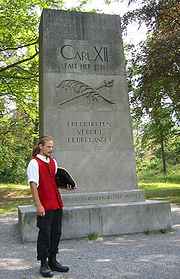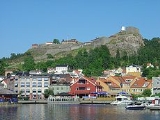
Fredriksten
Encyclopedia
History
This Fortresses was constructed ny Denmark-Norway in the 17th century as a replacement for the border fortress at BohusBohus Fortress
Bohus Fortress lies along the old Norwegian - Swedish border in Kungälv, Bohuslän, Sweden, north east from Hisingen where the Göta river splits into two branches...
, which had been lost when the province of Bohuslän
Bohuslän
' is a Swedish traditional province, or landskap, situated in Götaland on the northernmost part of the country's west coast. It is bordered by Dalsland to the northeast, Västergötland to the southeast, the Skagerrak arm of the North Sea to the west, and the county of Østfold in Norway to the north...
was ceded to Sweden
Sweden
Sweden , officially the Kingdom of Sweden , is a Nordic country on the Scandinavian Peninsula in Northern Europe. Sweden borders with Norway and Finland and is connected to Denmark by a bridge-tunnel across the Öresund....
by the terms of the Treaty of Roskilde
Treaty of Roskilde
The Treaty of Roskilde was concluded on 26 February or 8 March 1658 during the Second Northern War between Frederick III of Denmark–Norway and Charles X Gustav of Sweden in the Danish city of Roskilde...
in 1658. The fortress was named after King Fredrik III of Denmark and Norway
Frederick III of Denmark
Frederick III was king of Denmark and Norway from 1648 until his death. He instituted absolute monarchy in Denmark and Norway in 1660, confirmed by law in 1665 as the first in western historiography. He was born the second-eldest son of Christian IV of Denmark and Anne Catherine of Brandenburg...
, and the town of Halden was also originally named after him, having been known as Fredrikshald between 1665 and 1928.
The Northern War (1655–1661)
At the close of the Northern WarNorthern War and Norway
In the Second Northern War from 1655 to 1660, during the reign of Charles X, Sweden was set on expansion. Through military action, Sweden rapidly became the strongest military power in the north....
Charles X, having negotiated the Treaty of Roskilde in bad faith, invested
Investment (military)
Investment is the military tactic of surrounding an enemy fort with armed forces to prevent entry or escape.A circumvallation is a line of fortifications, built by the attackers around the besieged fortification facing towards the enemy fort...
Copenhagen in August of 1658. Under his orders, in September the new Swedish governor of Bohuslän invaded Norway with 1,500 men and attempted to invest Halden. The inhabitants put up a vigorous defense and the Swedish forces retreated back to Bohuslän.
Five months later in February of 1659 the Swedes again attacked. Since their first attack, the garrison had been strengthened. Under the leadership of Tønne Huitfeldt the Norwegian forces again repulsed the Swedish forces. Concurrently, Huitfeldt began construction of fortifications. Cretzenstein, later to be renamed Fredriksten, was the citadel of the new fortification system.
In early January of 1660, the Swedish forces attacked Halden for the third time; it was to serve as the base for their advance on Akershus fortress
Akershus Fortress
Akershus Fortress or Akershus Castle is a medieval castle that was built to protect Oslo, the capital of Norway. It has also been used as a prison.- Construction :...
in Christiania
Oslo
Oslo is a municipality, as well as the capital and most populous city in Norway. As a municipality , it was established on 1 January 1838. Founded around 1048 by King Harald III of Norway, the city was largely destroyed by fire in 1624. The city was moved under the reign of Denmark–Norway's King...
. Huitfeldt responded to their demand that they surrender, that the 2,100 man garrison would defend Halden to the last man. After the attempt to storm the fortifications was unsuccessful, the Swedes prepared a regular siege. Under heavy bombardment the inhabitants requested the commandant to surrender, but putting his faith in his garrison, Huitfeldt held out. On February 22, 1660 the Swedes again were forced to retreat to Bohuslen. There they learned that Charles X had died.
Peace negotiations were reopened. Sweden demanded that Norway vacate all land east of the river Glomma
Glomma
The Glomma or Glåma is the longest and largest river in Norway. The long river has a drainage basin that covers a full 13% of Norway's area, all in the southern part of Norway.-Geography:...
, which was to serve as the new border. With the intercession of Hannibal Sehested
Hannibal Sehested (governor)
Hannibal Sehested was a Danish statesman and Governor of Norway.He was born at Arensborg Castle on Øsel, Son of Claus Maltesen Sehested. After being educated abroad, he returned to Denmark in 1632 and was attached to the court of King Christian IV...
, a separate Scandinavia
Scandinavia
Scandinavia is a cultural, historical and ethno-linguistic region in northern Europe that includes the three kingdoms of Denmark, Norway and Sweden, characterized by their common ethno-cultural heritage and language. Modern Norway and Sweden proper are situated on the Scandinavian Peninsula,...
n treaty was negotiated which improved on the terms of the Treaty of Roskilde, returning Trøndelag
Trøndelag
Trøndelag is the name of a geographical region in the central part of Norway, consisting of the two counties Nord-Trøndelag and Sør-Trøndelag. The region is, together with Møre og Romsdal, part of a larger...
to Norwegian control.
Fortification Upgrades (1673 – 1675)

Gyldenløve
Gyldenløve is the name of two important noble families in Danish and Norwegian history. The first Gyldenløve family belonged to the Norwegian high nobility...
as statholder to Norway to organize the military forces and strengthen the defenses of the kingdom. After a tour of facilities, he recommended further upgrades to both the fortress and the military forces. In the summer of 1675, 1800 men were kept at work on the fortresses at Akershus
Akershus
- Geography :The county is conventionally divided into the traditional districts Follo and Romerike, which fill the vast part of the county, as well as the small exclave west of Oslo that consists of Asker and Bærum...
, Fredrikstad
Fredrikstad
is a city and municipality in Østfold county, Norway. The administrative centre of the municipality is the city of Fredrikstad....
, and Fredrikshald.
Gyldenløve War (1675–1679)
At the outbreak of the Gyldenløve War in 1675 a large contingent (4000 men) were concentrated at FredrikshaldFredrikshald
Fredrikshald may refer to:* Fredrikshald Bay, Nunavut, Canada* Fredrikshald, Norway, former name of the town of Halden...
under General Russenstein
Henrik Ruse
Henrik Ruse , later Baron Henrik Rysensteen , was a Dutch officer and fortification engineer...
. In 1676 Norwegian troops reoccupied Bohuslän
Bohuslän
' is a Swedish traditional province, or landskap, situated in Götaland on the northernmost part of the country's west coast. It is bordered by Dalsland to the northeast, Västergötland to the southeast, the Skagerrak arm of the North Sea to the west, and the county of Østfold in Norway to the north...
. In July of 1677 Gyldenløve
Gyldenløve
Gyldenløve is the name of two important noble families in Danish and Norwegian history. The first Gyldenløve family belonged to the Norwegian high nobility...
captured the fortress at Marstrand
Marstrand
Marstrand is a seaside locality situated in Kungälv Municipality, Västra Götaland County, Sweden. It had 1,432 inhabitants in 2005. It has held city privileges since 1200. The most striking feature about Marstrand is the 17th century fortress Carlsten, named after King Carl X Gustav of Sweden. The...
and joined General Løvenhjelm, who marched into Bohuslen with the main Norwegian army and defeated an army of 8000 Swedes under General de la Gardie
De la Gardie
De la Gardie, occasionally de la Gardie , is a Swedish noble family of French origin. The family's social status in France before the migration to Sweden is uncertain, they were possibly of lower gentry or bourgeoisie...
. A Norwegian force also retook Jämtland
Jämtland
Jämtland or Jamtland is a historical province or landskap in the center of Sweden in northern Europe. It borders to Härjedalen and Medelpad in the south, Ångermanland in the east, Lapland in the north and Trøndelag and Norway in the west...
, but withdrew again as ordered by the King. No major defensive activities were needed at Fredriksten as no Swedish forces crossed the frontier.
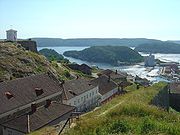
Fortification Upgrades (1679 – 1700)
Fredriksten was expanded from 1682–1701. It now included three outer fortifications: Gyldenløve, Overberget and Stortårnet.Great Northern War (1700–1721)
At the close of the Great Northern WarGreat Northern War and Norway
The Great Northern War was the war fought between a coalition of Denmark–Norway, Russia and Saxony-Poland on one side and Sweden on the other side from 1700 to 1721. It started by a coordinated attack on Sweden by the coalition in 1700, and ended 1721 with the conclusion of the Treaty of Nystad,...
, the Norwegian Army had been weakened in early 1716 by withdrawal of 5000 of the best troops to Denmark. When rumors reached Christiania that Charles XII
Charles XII of Sweden
Charles XII also Carl of Sweden, , Latinized to Carolus Rex, Turkish: Demirbaş Şarl, also known as Charles the Habitué was the King of the Swedish Empire from 1697 to 1718...
was preparing to invade, all remaining troops in Østerdal and Gudbrandsdal
Gudbrandsdal
The Gudbrandsdalen is a valley and traditional district in the Norwegian county of Oppland. The valley is oriented in a north-westerly direction from Lillehammer at Mjøsa, extending 230 km toward Romsdal...
were ordered to the border at Halden and Fredrikstad. The Norwegians expected the Swedes to invade at Kongsvinger
Kongsvinger
is a town and is a municipality in Hedmark county, Norway. It is part of the traditional region of Glåmdal. The administrative centre of the municipality is the town of Kongsvinger....
, Basmo
Basmo Fortress
Basmo fortress is located in the north-western part of Marker municipality in Østfold near the Swedish border on an isolated mountain outcropping between Rødenessjøen and Hemnessjøen....
and/or Halden. It was at Basmo where Charles XII struck, crossing the border March 8, 1716. The Norwegian scorched earth
Scorched earth
A scorched earth policy is a military strategy or operational method which involves destroying anything that might be useful to the enemy while advancing through or withdrawing from an area...
policy and guerrilla raid interdiction of supply chains by the residents of Bohuslen deprived Charles of supplies, while the fortresses still held by the Norwegians behind his lines threatened his supply chain and his retreat if seriously weakened in combat. Charles took Christiania (now Oslo), but without heavy siege artillery, was unable to take Akershus
Akershus Fortress
Akershus Fortress or Akershus Castle is a medieval castle that was built to protect Oslo, the capital of Norway. It has also been used as a prison.- Construction :...
.
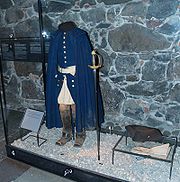
Norwegian Fortresses
Norwegian fortresses or fortifications have been constructed from some of the earliest recorded periods, down through the 20th century. The geography and topography of glacially carved, mountainous Norway constrain both the sea and the land routes which an aggresser must follow...
in southeastern Norway with the objective of capturing Frederiksten. This would remove the threat at his back, and the fortifications could serve as the base for a renewed offensive later that year. Capturing the harbours at the mouth of the Glomma
Glomma
The Glomma or Glåma is the longest and largest river in Norway. The long river has a drainage basin that covers a full 13% of Norway's area, all in the southern part of Norway.-Geography:...
river would also allow him to land the necessary provisions for a successful siege of Akershus.
Charles' troops attempted to take Frederiksten by storm on July 4. His troops took the town after fierce fighting, but the citizens set fire to their own houses, forcing Charles, unable to take the fortress, to retreat and await the arrival of heavy siege guns. Unfortunately for the invading army the entire Swedish transport fleet was captured or destroyed by the Norwegian naval hero Tordenskjold at the Battle of Dynekilen
Battle of Dynekilen
The naval Battle of Dynekilen took place on 8 July 1716 during the Great Northern War.-Background:On 28 October 1709 Frederik IV of Denmark, the Danish-Norwegian king declared the war against Sweden...
in Bohuslen. Running low on supplies, Charles retreated hastily across the Svinesund
Svinesund
Svinesund is a sound separating the Swedish municipality of Strömstad in the province of Bohuslän in the county of Västra Götaland from the Norwegian municipality of Halden in the county of Østfold....
and burned the bridges behind him. By July 12, 1716 all Swedish troops had been withdrawn from the area around Fredriksten.
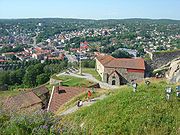
1814
The fortress was bombarded but not captured. The advancing Swedish forces of Charles JohnCharles XIV John of Sweden
Charles XIV & III John, also Carl John, Swedish and Norwegian: Karl Johan was King of Sweden and King of Norway from 1818 until his death...
passed it on their advance, leaving a force that tried to force its surrender, but the fortress and its commander kept the ground. It was turned over to Sweden after the Convention of Moss
Convention of Moss
The Convention of Moss was a cease fire agreement, signed August 14, 1814, between the Swedish King and the Norwegian Storting. It followed the Swedish-Norwegian War due to Norway's claim to sovereignty...
. The old fortress flag from 1814, taken by the Swedish troops and not returned to Norway until 1964, is preserved in the present day museum located inside the inner fortress.
The fortress today
